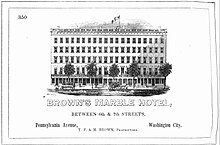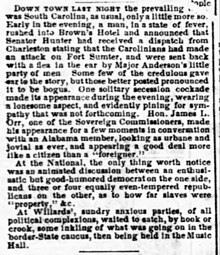Metropolitan Hotel (Washington, D.C.)

The Metropolitan Hotel at Pennsylvania Avenue and Sixth Street NW in Washington, D.C. was a major hotel of the capital city of the United States from 1863 to 1933. Built in 1850 by the heirs of Jesse Brown,[1] the Metropolitan was "brick with marble veneer, originally five stories, approx[imately] twenty bays."[2] In its day it was home "to many distinguished congressmen and visitors."[3] The Metropolitan had a reputation as the hotel of politicians from the Southern states.[4]
History
[edit]The history of the hotel that stood on Pennsylvania between Sixth and Seventh began with a land purchase in 1802.[5] The first owner constructed Woodward's Centre Tavern and arranged to have water piped to the building from a nearby spring.[5][6] Successive owner-operators of taverns on the block included Solomon Meyer, Robert Underwood, Nicholas L. Queen, George W. Lindsay, John Davis, and David McKeowin, all of whom built or linked extant structures in various combinations.[6] "The Star-Spangled Banner" was supposedly sung for the first time ever at this tavern in December 1814 "during a dinner given by the citizens of the district to the Secretary of the Navy, William Jones, who was resigning his office."[6][5] As Davis' Hotel it was the site of an inaugural ball for James Monroe.[4]
Finally, in 1821,[6] it was purchased by Jesse Brown "who had been for several years the proprietor of the City Hotel in nearby Alexandria. Brown called his Washington enterprise the Indian Queen Tavern—the name having probably been suggested from a hotel by the same name once kept by David Arrell on Market street in nearby Alexandria."[5] The Indian Queen had a large painted wooden carving of a stylized Native American woman as well a carved wooden sign that bore the motto "good entertainment for man and beast."[7] In the tavern era, "on a tall pole set at the footwalk were a bell and a rope. When meals were ready in the 'ordinary' a slave rang the bell and it could be heard along the avenue from Four and a Half to Ninth Street."[8] The Indian Queen tavern on the same site as the later Metropolitan was "the traffic centre of the old stage-coach days...From the courtyard in front of the old building the Baltimore and Philadelphia coaches started each morning, and thrice a week a coach left for the old National road line to Frederick, Cumberland and Pittsburg."[4]

The Indian Queen Tavern was enlarged and became Brown's Indian Queen Hotel. John Tyler was sworn in as president at the Indian Queen.[9] Charles Dickens visited on his American tour and mentioned the Indian Queen in Martin Chuzzlewitt.[4] Benjamin Perley Poore includes an extended description of the Indian Queen in his memoirs of life in 19th-century Washington, published 1887.[10] He recalled Jesse Brown preparing a "foaming eggnog" for patriotic holidays such as the Fourth of July and Washington's Birthday in a punch bowl that had allegedly belonged to George Washington .[10] Pushmataha reportedly stayed at the hotel when visiting Washington for treaty negotiations, "as did many Indian delegations."[5]
Jesse Brown died in 1847, at age 74, and his sons Tillotson P. Brown and Marshall Brown took over.[11][6] The old building was demolished in 1850.[12] The cornerstone of the new Brown's Hotel was laid in May 1851, with construction projected to be completed "October next."[13] Items deposited in the time capsule in the cornerstone included grains of gold brought by John Walker from California, a copy of the Declaration of Independence and "Rev. C. M. Butler's Thanksgiving Sermon," and "pennies by the old colored servants, put in for ' good luck,' and to 'the memory of their old master.'"[13] The architect of the new building was John Haviland.[13] The marble of Brown's Marble Hotel came from Maryland[4] and/or was supposedly left over from the construction of the U.S. Capitol building.[6] A new proprietor began leasing the building in 1862 and changed the name from Brown's Hotel to the Metropolitan Hotel.[14][15] The Brown family sold out entirely in 1865.[3][9] The hotel had a "broad, low ceiled lobby" that was usually "filled with broad-hatted frock-coated men" and reminded people more or "Memphis or New Orleans than of the Northern cities. The bar was always famous for its juleps, toddies, and sherry cobblers."[4]


As of 1884, the old tavern building was "yet a part of the back of the hotel."[16]
The building was razed in 1933.[17][12] Some of the bricks were repurposed in the construction of a Georgian-style home on Massachusetts Avenue.[18] The lot was then used as a bus station.[5] As of the 1960s, the location was Barney's restaurant and "a two-story, two-bay fragment from the southwest corner now survives, first floor altered, second floor retains original Greek Revival marble trim."[2] The remaining fragment was demolished in 1984.[12]
See also
[edit]References
[edit]- ^ "Metropolitan Hotel - D.C. Public Library Historic Image Collection".
- ^ a b "District of Columbia catalog; a list of measured drawings, photographs, and written documentation in the Survey. Nancy K. Beinke, editor". HathiTrust. Historical American Buildings Survey. p. 19. hdl:2027/mdp.39015011960674. Retrieved 2023-12-29.
- ^ a b Reed, Robert (2013-06-18). Old Washington, D.C., in Early Photographs, 1846-1932. Courier Corporation. ISBN 978-0-486-13854-1.
- ^ a b c d e f "Blackstone Courier 25 June 1909 — Virginia Chronicle: Digital Newspaper Archive". virginiachronicle.com. Retrieved 2023-12-29.
- ^ a b c d e f Proctor, John Clagett (1940-01-14). "Early Jackson Democrats Held Meetings at Brown's Indian Queen Hotel". Evening star. p. 34. Retrieved 2023-12-29.
- ^ a b c d e f Proctor, John Clagett (1932-09-25). "Riots Quelled by Troops in Early Days". Evening star. p. 74. Retrieved 2023-12-29.
- ^ "Inns of Old Washington". The Washington Times. 1901-07-07. p. 1. Retrieved 2023-12-29.
- ^ "Article clipped from Evening star". Evening star. 1925-02-01. p. 75. Retrieved 2023-12-29.
- ^ a b Carrier, Thomas J. (1999). Washington, D.C.: A Historical Walking Tour. Arcadia. p. 47. ISBN 9780738500492.
- ^ a b "Perley's reminiscences of sixty years in the national metropolis / by Ben: Perley Poore. v.1-2". HathiTrust. pp. 42–44. hdl:2027/hvd.32044014260442. Retrieved 2023-12-29.
- ^ "Brown's Hotel". The Washington Union. 1847-07-26. p. 4. Retrieved 2023-12-29.
- ^ a b c "Brown's Marble Hotel - DC Public Library Historic Image Collection".
- ^ a b c "Local Matters". The Daily Republic. 1851-05-09. p. 3. Retrieved 2023-12-29.
- ^ "Article clipped from National Republican". National Republican. 1862-01-06. p. 3. Retrieved 2023-12-29.
- ^ "Brown's Hotel Changes Hands". Evening star. 1861-12-16. p. 3. Retrieved 2023-12-29.
- ^ Barton, Elmer Epenetus (1884). Historical and Commercial Sketches of Washington and Environs: Our Capital City, "the Paris of America": Its Prominent Places and People ... Its Improvements, Progress and Enterprise ... E.E. Barton. p. 121.
- ^ "District Once Had Tammany Society". Evening star. 1933-07-09. p. 68. Retrieved 2023-12-29.
- ^ "Georgian Features Revealed in New Home". Evening star. 1934-05-12. p. 19. Retrieved 2023-12-29.
External links
[edit]
